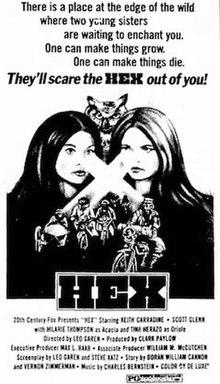
Gary Busey is an American actor. He is known for his portrayal of Buddy Holly in The Buddy Holly Story (1978), for which he was nominated for the Academy Award for Best Actor and won the National Society of Film Critics Award for Best Actor. His other starring roles include Gumball Rally (1976) A Star is Born (1976), D.C. Cab (1983), Silver Bullet (1985), Lethal Weapon (1987), Predator 2 (1990), Point Break (1991), Under Siege (1992), Rookie of the Year (1993), The Firm (1993), Black Sheep (1996) and Lost Highway (1997).

Rosemary's Baby is a 1967 horror novel by American writer Ira Levin; it was his second published book. It was the best-selling horror novel of the 1960s, selling over 4 million copies. The high popularity of the novel was a catalyst for a "horror boom", and horror fiction would achieve enormous commercial success.

Revenge of the Nerds is a 1984 American comedy film directed by Jeff Kanew and starring Robert Carradine, Anthony Edwards, Ted McGinley, and Bernie Casey. The film's plot chronicles a group of nerds at the fictional Adams College trying to stop the ongoing harassment by the jock fraternity, the Alpha Betas, in addition to the latter's sister sorority, Pi Delta Pi.

Suspiria is a 1977 Italian supernatural horror film directed by Dario Argento, who co-wrote the screenplay with Daria Nicolodi, partially based on Thomas De Quincey's 1845 essay Suspiria de Profundis. The film stars Jessica Harper as an American ballet student who transfers to a prestigious dance academy but realizes, after a series of brutal murders, that the academy is a front for a supernatural conspiracy. It also features Stefania Casini, Flavio Bucci, Miguel Bosé, Alida Valli, Udo Kier, and Joan Bennett, in her final film role.

David Carradine was an American actor, director, and musician, whose career included over 200 major and minor roles in film, television and on stage, spanning more than six decades. He was widely known to television audiences as the star of the 1970s television series Kung Fu, playing Kwai Chang Caine, a peace-loving Shaolin monk traveling through the American Old West.

The Sentinel is a 1977 American supernatural horror film directed by Michael Winner, and starring Cristina Raines, Chris Sarandon, Ava Gardner, Burgess Meredith, Sylvia Miles, and Eli Wallach. The plot focuses on a young model who moves into a historic Brooklyn brownstone that has been sectioned into apartments, only to find that the building is owned by the Catholic diocese and is a gateway to Hell. It is based on the 1974 novel of the same name by Jeffrey Konvitz, who also co-wrote the screenplay with director Winner. It also features Christopher Walken, Jeff Goldblum, John Carradine, Jerry Orbach, Tom Berenger, Nana Visitor and Beverly D'Angelo in supporting roles.

House of Dracula is a 1945 American horror film released and distributed by Universal Pictures. Directed by Erle C. Kenton, the film features several Universal Horror properties meeting as they had done in the 1944 film House of Frankenstein. The film is set at the castle home of Dr. Franz Edelmann, who is visited first by Count Dracula and later by Larry Talbot, the Wolf Man, who are trying to cure their vampirism and lycanthropy, respectively. Talbot is eventually cured, which leads him to discover the body of Frankenstein's monster in a cave below the base of the castle. Edelemann takes the monster's body back to his laboratory but finds Count Dracula has awakened and by attacking his assistants, he captures Edelmann and forces a reverse blood transfusion, which gives Edelmann a split personality and makes him a killer.

Incubus is a 1982 Canadian supernatural slasher film directed by John Hough and written by George Franklin, based on the 1976 novel of the same name by Ray Russell. It stars John Cassavetes, Kerrie Keane, and John Ireland. The plot focuses on a small Wisconsin town where a mysterious figure is raping and murdering young women. Its title is sometimes extended to The Incubus.
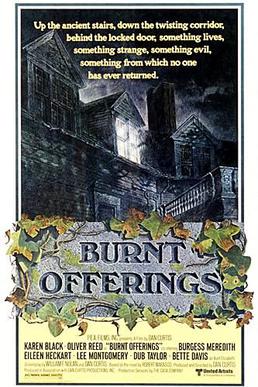
Burnt Offerings is a 1976 American supernatural horror film co-written and directed by Dan Curtis and starring Karen Black, Oliver Reed, Bette Davis, and Lee H. Montgomery, with Eileen Heckart, Burgess Meredith and Anthony James in supporting roles. It is based on the 1973 novel of the same name by Robert Marasco. The plot follows a family who begins to interpersonally dissolve under supernatural forces in a large estate they have rented for the summer.

Cristina Raines is an American former actress and model who appeared in numerous films throughout the 1970s, mainly horror films and period pieces. She went on to have a prolific career as a television actress throughout the 1980s.
Retrosheet is a nonprofit organization whose website features box scores of Major League Baseball (MLB) games from 1906 to the present, and play-by-play narratives for almost every contest since the 1930s. It also includes scores from every major league game played since the 1871 season, as well as all All-Star Games and postseason games, including the World Series.

Hello Mary Lou: Prom Night II is a 1987 Canadian supernatural slasher film directed by Bruce Pittman, and starring Michael Ironside, Wendy Lyon, Louis Ferreira, and Lisa Schrage. It follows a high school student who becomes possessed by Mary Lou Maloney, a student who died at her high school prom in 1957. A sequel to the slasher film Prom Night (1980), it was originally intended to be a standalone film titled The Haunting of Hamilton High, but was retitled in order to capitalize on the success of the original Prom Night. The only connection between the two films, that the high schools where the films are set have the same name, was a complete coincidence.

The Boogeyman is a 1980 American supernatural slasher film written and directed by Ulli Lommel, and starring Suzanna Love, John Carradine, and Ron James. The film's title refers to the long-held superstition of boogeymen beings, and its plot concerns two siblings who are targeted by the ghost of their mother's deceased boyfriend which has been freed from a mirror.
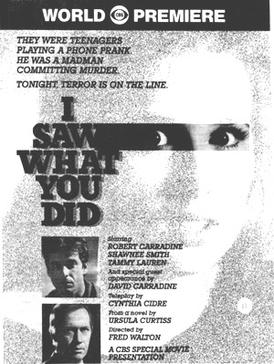
I Saw What You Did is a 1988 American made-for-television horror film directed by Fred Walton, with a screenplay by Cynthia Cidre. It is a remake of the 1965 theatrical film of the same name starring Joan Crawford, and the second adaptation of Out of the Dark by Ursula Curtiss. The film stars Shawnee Smith and Tammy Lauren as teenage friends Kim Fielding and Lisa Harris, respectively, and Candace Cameron as Kim's younger sister Julie; opposite them is Robert Carradine as the mentally disturbed Adrian Lancer, and David Carradine as his brother Stephen. While making prank phone calls pretending to know who the other person is and what they've done, Kim and Lisa call Adrian, who has recently murdered his girlfriend, causing him to set out to find them.

Full Circle, released in the United States as The Haunting of Julia, is a 1977 supernatural horror film directed by Richard Loncraine, and starring Mia Farrow and Keir Dullea. Based on the novel Julia by the American writer Peter Straub, it is the first film realization of one of his books, and follows a woman who, after the death of her daughter, finds herself haunted by the vengeful ghost of a young girl in her new home.

The Nesting is a 1981 American supernatural horror film directed and co-written by Armand Weston, and starring Robin Groves, Michael Lally, John Carradine and Gloria Grahame in her final film role. Its plot follows an agoraphobic novelist who rents a rural mansion that she comes to find is haunted.
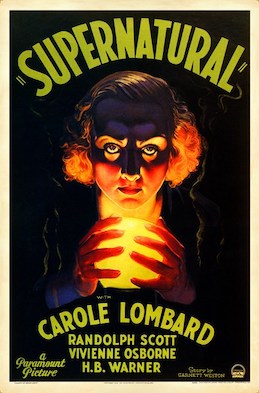
Supernatural is a 1933 American pre-Code supernatural horror film directed by Victor Halperin, and starring Carole Lombard and Alan Dinehart. The film follows a woman who attends a staged séance only to find herself possessed by the spirit of an executed murderess.
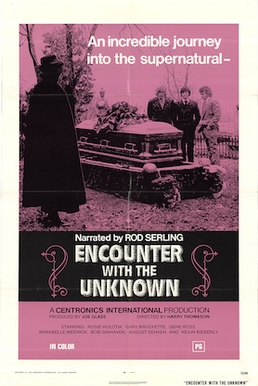
Encounter with the Unknown is a 1972 American anthology horror film directed by Harry Thomason in his directorial debut, and narrated by Rod Serling. It features three allegedly true stories involving the supernatural. The film was produced by Centronics International, an Arkansas-based studio founded by Thomason.

The Cat Creature is a 1973 American made-for-television horror film produced by Douglas S. Cramer and directed by Curtis Harrington from a teleplay by Robert Bloch and starring Meredith Baxter, David Hedison and Gale Sondergaard. The film serves as a tribute to the low-budget Val Lewton horror films of the 1940s and also features an appearance by Kent Smith, who starred in Lewton's original classic Cat People (1942) and its sequel The Curse of the Cat People (1944). It originally premiered as the ABC Movie of the Week on December 11, 1973.
